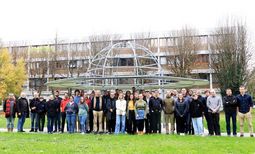A new milestone in space exploration was reached today with the publication in Astronomy & Astrophysics of the first scientific results from the Near-InfraRed Planet Searcher (NIRPS), co-led by scientists at Université de Montréal.
A high-resolution spectrograph specially designed to detect exoplanets and analyze their atmospheres and operational since April 2013, NIRPS represents a major technological advance in the search for habitable worlds beyond our solar system.
Installed on the 3.6-meter telescope at La Silla Observatory in Chile, it involves a consortium of over 140 specialists from six countries: Canada, Switzerland, Spain, Portugal, France and Brazil, with support from the European Southern Observatory.
The Canadian team, notably from the Observatoire du Mont-Mégantic and the Trottier Institute for Research on Exoplanets at Université de Montréal, played a crucial role in the NIRPS project.
The instrument's uniqueness lies in its ability to observe in the near-infrared, making it particularly effective for studying cool, red stars called M dwarfs. These stars, the most numerous in our galaxy, emit their light primarily in the infrared, making NIRPS ideal for detecting small, Earth-like planets orbiting these stars.
Unique technological synergy
One of NIRPS's most remarkable innovations is its ability to work in tandem with HARPS (High Accuracy Radial velocity Planet Searcher), a spectrograph that observes in visible light and has been operating on the same telescope since 2003.
This combination allows simultaneous observation of the same star in both visible and infrared light, offering a rare ability to distinguish true planetary signals from "noise" caused by stellar activity such as flares, spots, or magnetic activity.
The instrument is also equipped with an adaptive optics system that corrects for Earth's atmospheric distortions, improving observation quality while maintaining a compact and efficient design. This technology achieves remarkable precision on the order of one meter per second, comparable to the best instruments operating in visible light.
NIRPS uses the radial velocity method to detect exoplanets by measuring the tiny back-and-forth motions of a star caused by the presence of an orbiting planet. Detecting a planet as light as Earth around an M dwarf represents a considerable challenge, requiring precision on the order of 3.6 kilometres per hour.
According to UdeM professor René Doyon, co-principal investigator of the project, "for the first time we achieve sub-meter-per-second precision in the infrared, comparable to that of the best visible-light instruments."
Beyond planetary detection, NIRPS excels in analysis of exoplanet atmospheres thanks to its infrared sensitivity, which allows identification of key chemical signatures such as water vapour, helium or methane.
Promising first results
NIRPS's first results already demonstrate its scientific power.
A Spanish team led by Alejandro Suárez Mascareño confirmed the existence of Proxima Centauri b, an Earth-like planet in the habitable zone of our nearest star. The team also detected evidence of a second, even less massive planet around the same star, highlighting NIRPS's remarkable sensitivity to low-mass planets.
Meanwhile, a study led by Romain Allart, a postdoctoral researcher at UdeM and IREx, revealed the presence of a helium gas tail escaping from the atmosphere of WASP-69 b, a Saturn-mass exoplanet. This detailed observation provides crucial new information about the evolution of planetary atmospheres under intense stellar radiation.
In exchange for building the instrument, the consortium obtained 725 guaranteed observation nights, representing 40 per cent of the telescope's time. This allows the team to receive new data daily and pursue three main objectives: search for planets around M dwarfs, measure the mass of known planets, and study the atmospheres of various exoplanets.
NIRPS will play a strategic role in identifying the most promising targets for atmospheric observations with the James Webb Space Telescope, and later in the search for biosignatures with the future European Extremely Large Telescope.
"NIRPS is the result of lessons learned from previous spectrographs, innovative new technologies, and fruitful international collaboration," said the instrument's co-principal investigator François Bouchy, from the Observatoire de Genève, in Switzerland.
About this study
"NIRPS joining HARPS at the ESO 3.6m: on-sky performance and science objectives," led by François Bouchy from the Observatoire de Genève at Université de Genève, was published July 29, 2025, in Astronomy & Astrophysics.
The research team includes 32 co-authors from Université de Montréal's Trottier Institute for Research on Exoplanets (IREx) and the Observatoire du Mont-Mégantic, and 109 other co-authors from Germany, Brazil, Canada, Chile, Spain, France, Portugal, and Switzerland.







